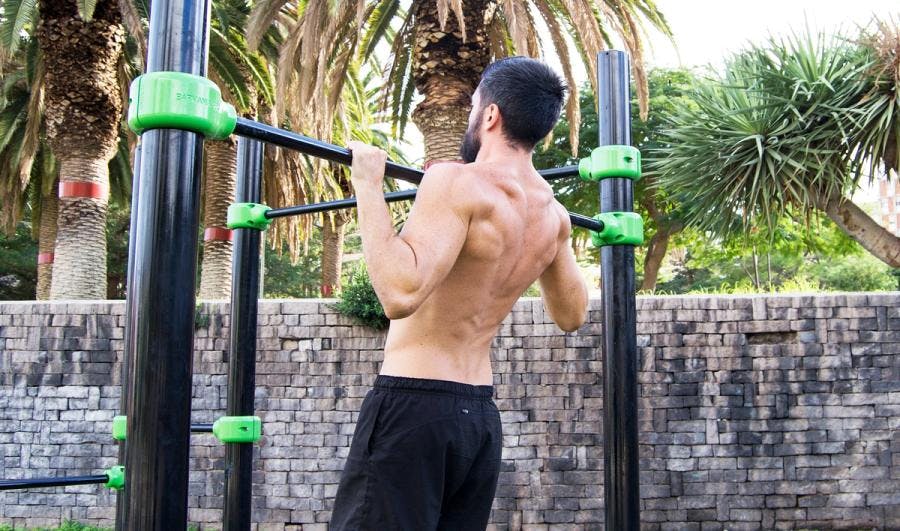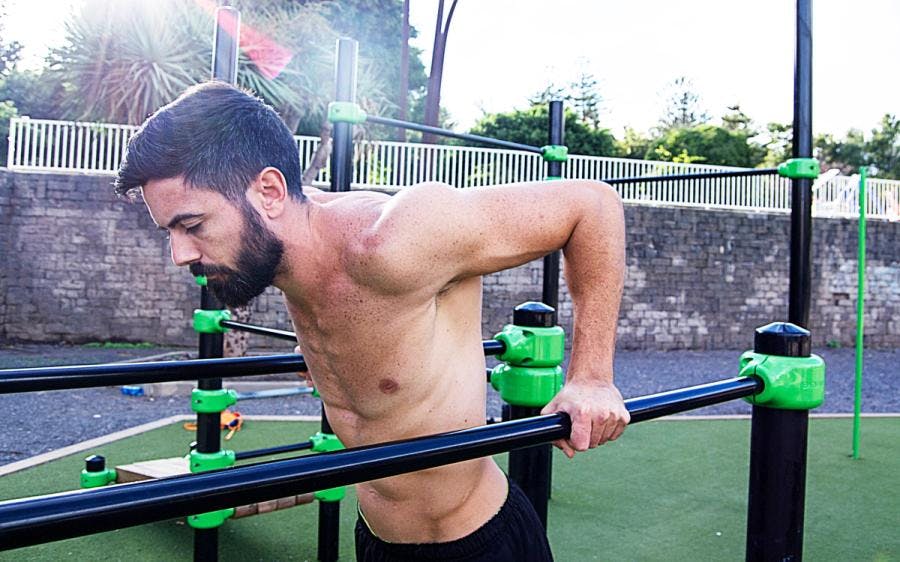
Partial range reps are often subject of controversy in calisthenics and its effectiveness over full-range reps is often questioned. In this article, you will find a detailed analysis of what each one involves, its usefulness, its advantages and disadvantages, how to incorporate them into our workouts and the controversy over partial reps in calisthenics.
FULL RANGE
The maximum possible range in each exercise is called full range. It usually starts with a locking position of the knees or elbows, to the point where it is considered full range. For example, push- ups are usually considered full range when the chest hits the ground; in dips exercises, when it exceeds 90 degrees; in chin-ups, when the chin passes over the bar without hyperextending. It all depends on how strict you want to be. What is clear is what is not considered full range, which is, for example, in dips, not reaching 90 degrees or, in chin-ups, not reaching the bar with the chin or if you do not block completely in all these exercises.
Another interesting aspect of full range reps is that it does not have the same degree of difficulty in each part of the movement. For example, in the case of chin-ups, the initial part of the movement and the upper part of the range is more difficult than the middle part. In the case of push-ups, the hardest part is to come out from the bottom and the easiest part is the middle part, so when people do 0 reps one of the main mistakes is that they do not reach all the way down. The second hardest part is blocking completely because in the more difficult parts of the range we tend to have a worse angle in the different muscles involved.
PARTIAL RANGE
Therefore, anything other than full range is considered partial range: from not locking the elbows or knees correctly, to not reaching the point where the rep is considered complete, as mentioned above.
Partial range can be done intentionally to work on something specific or it could be done because we do not know how to do the full range properly; or, in most cases, because we simply want to do the maximum number of reps in the shortest time regardless of the form and we end up doing 0 reps.

ADVANTAGES: FULL RANGE
One of the many positive aspects of the full range is that it can be used as a reference to objectively count the reps and compare the correct execution of the technique between two or more people, in such a way that a unified consensus is established. It is necessary that this consensus exists as a reference to be able to judge in the most objective way possible the number of repetitions that a person does, either its maximum or in comparison to other people, not only in competitions but also in social networks or even among friends . We must not forget that, after all, calisthenics by definition is characterized for seeking the correct execution of all exercises and that is what we must strive for.
DISADVANTAGES: FULL RANGE
The main disadvantage is that it can be a bit painful or dangerous for the joints if not planned properly. For example, if a person who is not used to a certain exercise does too many full range reps of that exercise, this continuous hitting of the joints may be a bit harmful. However, as we have pointed out, this is a planning failure.
This occurs when we perform an exercise at the limit of our capacity and to which we are not used to and, even so, we do too many reps. However, if we do a progressive work, the muscle adapts first and then the connective tissue (tendons), in such a way that it gradually strengthens without having to experience pain or discomfort.
The second disadvantage is that we do fewer reps when we do them at full range than at partial range, since there is usually a weak point in the full range that is going to limit the number of reps. Nevertheless, it is important to keep in mind that your weakest point sets the limit of your capability.

ADVANTAGES AND DISADVANTAGES: PARTIAL RANGE
The first advantage of partial range is that it can be used to strengthen those parts of the movement (the upper, middle and lower part) in which we are weaker. By focusing attention on that specific part, it is strengthened and it will therefore allow us to increase the number of reps or lift more weight.
In addition, in order to work on hypertrophy with calisthenics, several additional factors need to be taken into account. In general terms, to build muscle mass you have to give a proper stimulus to the muscle you want to increase. The current scientific opinion establishes that the optimal and most efficient way to do this is to work the muscle between 60% and 80% of its capacity. This can be conditioned if the number of reps is limited by a specific part of the range. For example, I need to do 15 pull-ups to reach a muscle stimulus of 80%, but since I have a weak part, I can only do 10 and, therefore, I do not get to work in that 80%.
In that case, we can also use the middle part of the range movement and do 20 reps only in the middle part and, in that way, we would stimulate the muscle for a hypertrophy work. That is one of the reasons why people who work a lot of hypertrophy, tend to do reps in the middle range (push-ups without reaching all the way down, mid-chin-ups, etc.). Because, as we have seen, this method is effective for hypertrophy, you simply have to work in that range until you feel sufficient stimulus.
Nevertheless, with the appropriate theoretical knowledge we can identify that this may be a failure in planning. For example, if I cannot reach 80% of my muscle capacity by doing prone chin-ups, I can do supine or even Australian chin-ups instead, to get to that 80%. The key is not obsessing over getting hypertrophy by doing just one exercise.
Another option we have for hypertrophy work and getting used to full-range work would be to do full range at first and as we increase fatigue, make the range shorter and shorter. This would help us get to that 80% stimulus without giving up the full range.
When we are beginners, the partial range can be very useful when we are learning an exercise. For example, when we cannot do chin-ups, we can do partial range in supine or prone chin-ups, or simply work scapular retractions. The same happens with dips, it can be very useful to work them in partial range to strengthen and make the range longer and longer until it becomes full range. Partial range can also be used to increase the time under tension of a certain muscle. Particularly, with leg workouts and specifically glute workouts.
CONCLUSION
Partial range can be very useful in our workouts, but it is crucial knowing for and why it is used. Another important aspect to take into account is that calisthenics, as a sport, seeks to the correct technical execution and thus the full range exercises. Therefore, although partial range can be used conscientiously to strengthen specific parts of the muscle; it is important to always aim for full range. Especially when we share a video on social networks doing our maximum number of reps, we must try to do them at full range as an objective reference so that there can be healthy and fair competition.
If you have any doubts about how to incorporate partial range exercises in your workouts, Calisteniapp offers you several routines that include partial reps as a progression, such as the “Your first pull-up” program or this back routine for beginners. Moreover, in the Smart Progress of Your First Muscle Up partial repetitions are used as a progression.
Written by Johanna Suárez Hernández
Autore

Yerai Alonso
Cofundador de Calisteniapp, referente en calistenia y el street workout en Español. Con más de una década de experiencia, es creador de uno de los canales de YouTube más influyentes del sector. Autor del libro La calle es tu gimnasio, campeón de Canarias y jurado en competiciones nacionales e internacionales.
Unisciti alla nostra newsletter
NUOVI ARTICOLI OGNI SETTIMANA
Impara tutto quello che devi sapere sulla calisthenica
Calisteniapp
Inizia l'allenamento di calistenia e street workout
